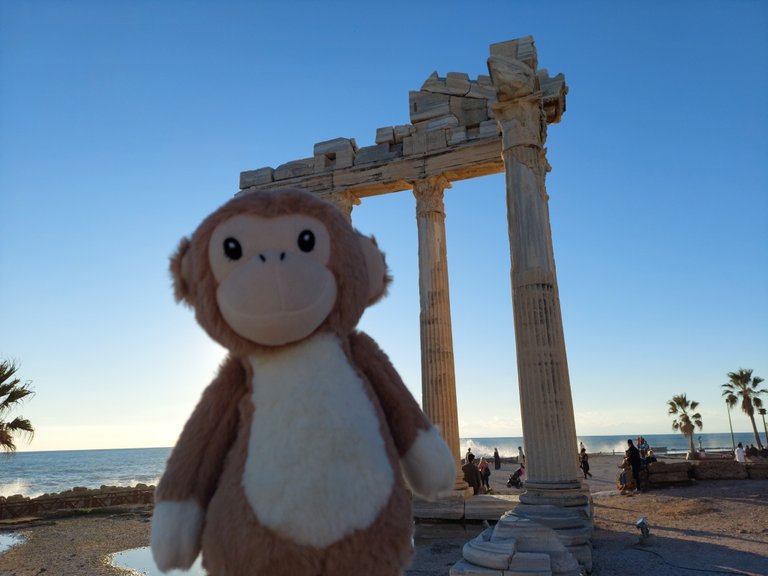
When I was in university, Side was one of my research topics. I used to come here often, wandering among the structures and statues until I got tired, eventually sitting on a stone by the shore, delving into deep thoughts about the city's history. Initially, I felt unlucky to be assigned a Pamphylian city. At that time, I was more of a Lycia enthusiast. The Lycians were heroes, they preferred to throw themselves into fire rather than surrender the city to the enemy, they didn't engage in things like slave trade that restricted people's freedoms and so on. Gradually, maybe as I got to know it better, I couldn't remain indifferent to Pamphylia, with its serene atmosphere by the deep blue sea, golden beaches and impressive colors painted by the sunset. The other day, after a long time, I went back to Side, wandered through the ancient and modern city, refreshing my old memories.
Side üniversitedeyken araştırma konularımdan biriydi. Buraya sıkça gelip yorulana kadar yapı ve heykellerin arasında dolaşır, sonunda sahildeki bir taşın üstüne oturup kentin geçmişi ile ilgili derin düşüncelere dalardım. İlk başlarda payıma bir Pamfilya kenti düştüğü için kendimi şanssız olarak görüyordum. O zamanlar ben daha ziyade Likya hayranıydım. Likya'lılar kahramandı, şehri düşmana teslim etmek yerine kendilerini ateşe atmayı yeğlemişlerdi, köle ticareti gibi insanların özgürlüklerini kısıtlayan şeylerle uğraşmamışlardı vs. Ama zamanla ve belki de tanıdıkça masmavi denizinin huzur verici atmosferine, altın kumsallarına, güneşin batışında büyüleyici renklere boyanan Pamfilya'ya kayıtsız kalamadım. Geçen gün uzun aradan sonra Side'ye tekrar gittim, antik ve modern kenti dolaşıp eski anılarımı tazeledim.
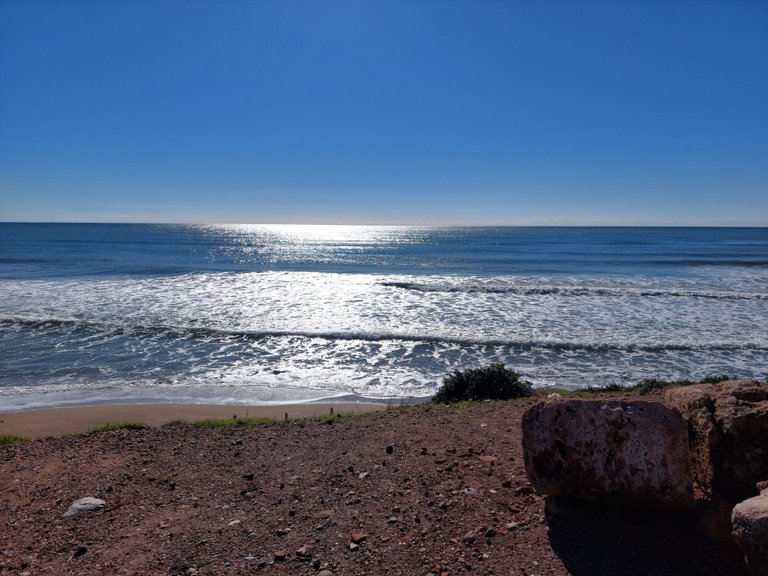
Side: In the Footsteps of the Pomegranate Goddess - Side: Nar Tanrıçasının İzinde
To get to Side, one needs to depart from Antalya and head towards Alanya. I arrive there after about an hour's journey from Antalya. The history of this ancient city dates back to the 7th century BC. However, historical sources indicate the existence of even older civilizations here, though tangible evidence confirming this is yet to be found. Nevertheless, intensive archaeological excavations continue in the region.
In ancient Anatolian languages, Side meant "pomegranate." Throughout history, various foods have been regarded as symbols of abundance. One of these symbols was the pomegranate, seen as a fruit of prosperity by the ancient peoples of Anatolia. The statues of the main goddess Cybele holding a pomegranate serve as a testament to this belief. [Source 1]
One of the most frequently told legends in Side relates to the daughter of a mountain god associated with the pomegranate. The mountain god's beautiful daughter was named Side. One day, she descends to gather flowers by the banks of the Manavgat River and when she trips and cannot free herself, she transforms into a tree. The fruits of this tree, drenched in Side's blood, turn into nothing other than pomegranates. [2]
We see pomegranates depicted on coins minted in Side during ancient times. Furthermore pomegranates are encountered in sculptures of gods and goddesses familiar from Roman mythology found in Side. The residents of Side did not overlook adorning these gods brought from the Greeks with their own local motifs.
Side'ye gitmek için Antalya'dan çıkıp Alanya istikametine gitmek gerekir. Ben Antalya'dan yaklaşık bir saatlik yolculuk sonunda varıyorum. Bugünkü antik kentin geçmişi m.ö. 7 yüzyıla kadar uzanıyor. Ama tarihi kaynaklar burada çok daha eski uygarlıkların da yaşadığına işaret ediyor. Henüz bunu kanıtlayacak bir kalıntıya ulaşılmasa da bölgedeki arkeolojik kazılar hummalı bir şekilde devam ediyor.
Side eski Anadolu dillerinde Nar anlamına geliyordu. Bildiğimiz gibi tarih boyunca farklı besinler bereket sembolü olarak kabul görmüştür. Bu sembollerden biri de nardı ve Anadolu'nun eski halkları tarafından bereket meyvesi olarak görülüyordu. Elinde nar tutan ana tanrıça Kybele heykelleri de adeta bunun bir kanıtı. [Kaynak 1]
Side'de nar ile ilgili en sık anlatılan efsane dağ tanrısının kızı ile ilgili. Dağ tanrısı Toros'un güzel kızının adıdır Side. Bir gün Manavgat ırmağının kıyısına çiçek toplamaya iner ve ayağı takılıp kurtulamayınca bir ağaca dönüşür. Side'nin kanıyla kıpkırmızı renklere boyanan bu ağacın meyveleri ise nardan başka bir şey değildir. [2]
Narı antik dönemde basılmış Side sikkelerinde görüyoruz. Ayrıca Side'de Roma mitolojisinden tanıdığımız tanrı ve tanrıça heykellerinde de nara rastlanıyor. Sideliler Greklerden gelen bu tanrıları kendi yerel motifleriyle süslemeyi ihmal etmemişler.
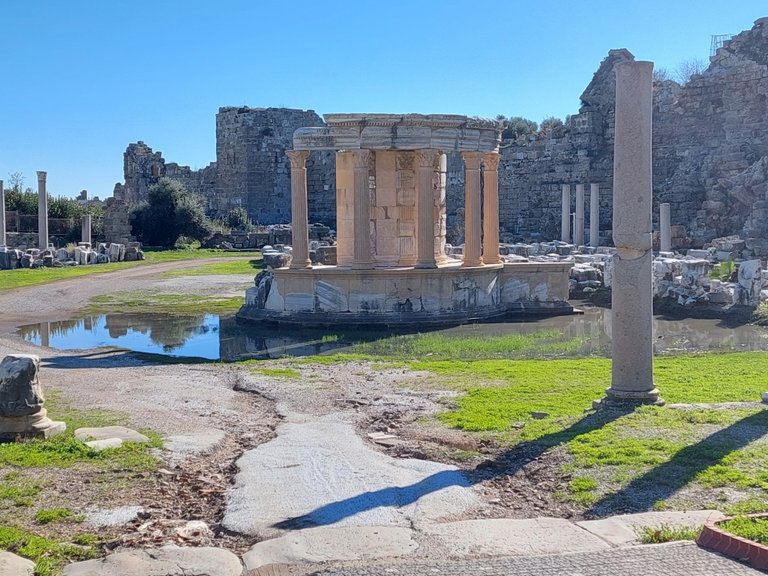
The Temple of Tyche or Fortuna - Tykhe ya da Fortuna Tapınağı
In ancient Side, magnificent temples take precedence. One of these is the Temple of Tyche, situated right in the heart of the city's agora. Tyche, also known as Fortuna, was the goddess of commerce and luck. It's likely that traders would come to this temple, located at the very center of the agora, to pray for their business endeavors to prosper.
Antik Side'de gösterişli tapınaklar ağır basıyor. Bunlardan biri kentin agorasının tam ortasında yer alan Tykhe tapınağı. Tykhe ya da bir başka adıyla Fortuna ticaret ve şans tanrıçasıydı. Agoranın tam ortasında bulunan tapınağına muhtemelen tüccarlar gelip işlerinin rast gitmesi için dualar ederlerdi.

Side has a magnificent agora. According to what we've learned from Strabo's books, Side was a renowned beauty, a port where slaves were traded. Cilician pirates used to sell the slaves they captured in these parts. Strabo writes that even though the Pamphylians didn't approve of restricting people's freedom, they turned a blind eye to it for profit. However the Lycians never engaged in such dealings. [3]
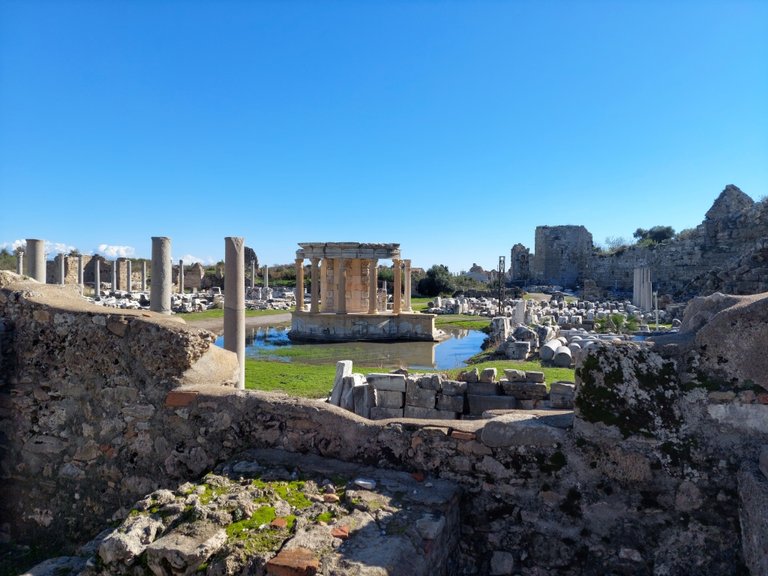
Side'nın ve gösterişli bir agorası var. Strabon'un anlattıklarından öğrendiğimiz kadarıyla Side güzellikleri dillere destan kölelerin satıldığı bir limandı. Kilikya'lı korsanlar ele geçirdikleri köleleri buralarda satarlarmış. Strabon, insanların hürriyetinin kısıtlanmasını onaylamadıkları halde kazanç için Pamfilyalıların buna göz yumduklarını yazıyor. Likyalılar ise asla bu tür işlere kalkışmamışlar. [3]
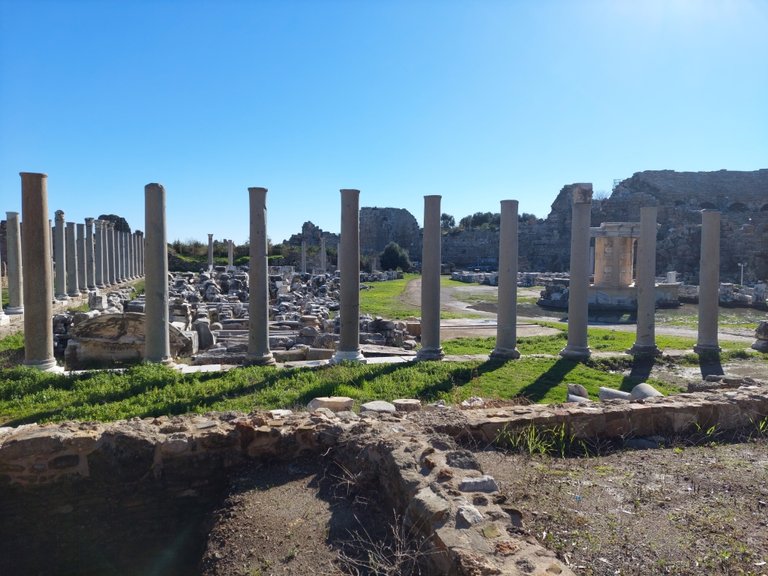
The likelihood of slaves being exhibited in the podium section of the Temple of Tyche seems significant. The temple is circular and features columns with Corinthian capitals.
Tykhe tapınağının podyum kısmında kölelerin sergilenmiş olması ihtimali ağır basıyor. Tapınak yuvarlak olup, Korint başlıklı sütunlara sahip.

In one corner of the magnificent agora, there is an ancient toilet called a "latrina". In ancient times, latrines were seen as socializing spots, where people would also come to chat and converse.
Gösterişli agoranın bir köşesinde latrina adı verilen antik tualet de mevcut. Eski dönemde latrinalar sosyalleşme yeri olarak görülürdü ve insanlar buraya sohbet muhabbet etmek için de gelirlerdi.
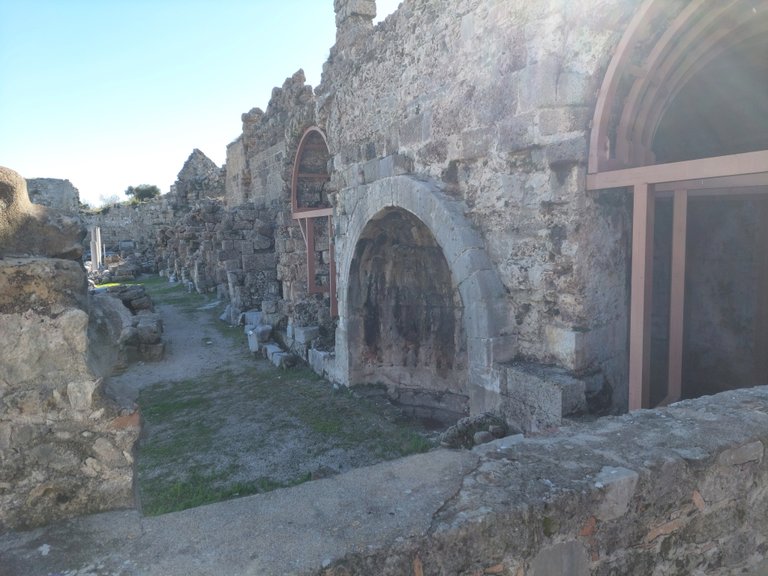
The Columned Street - Sütunlu Cadde
The colonnaded streets of Side start right at the main gate and extend almost to the seashore. Magnificent columns line both sides of the street. This street has been used for a long time, worn down over time and various civilizations that have lived here throughout history have naturally added things, carried out repair works. Hence it's possible to come across remnants from different periods along these streets.
Side'nin sütunlu caddeleri ana kapıdan girince başlıyor ve neredeyse sahile kadar uzanıyor. Caddenin her iki tarafında gösterişli sütunlar yer alıyor. Bu cadde uzun süre kullanılmış, zamanla yıpranmış ve tarih boyunca burada yaşayan farklı uygarlıklar kendiliklerinden bir şeyler eklemişler, onarım çalışması yapmışlar. Bu nedenle caddelerde farklı dönemlere ait kalıntılara rastlamak mümkün.
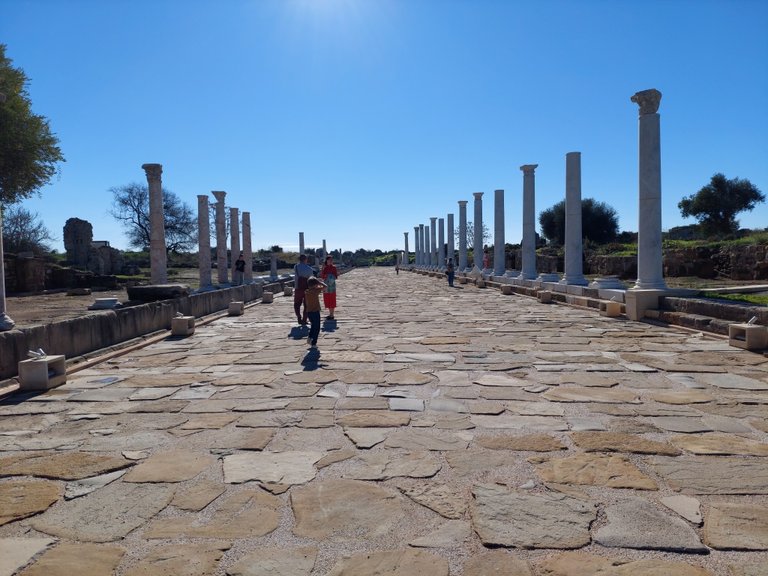

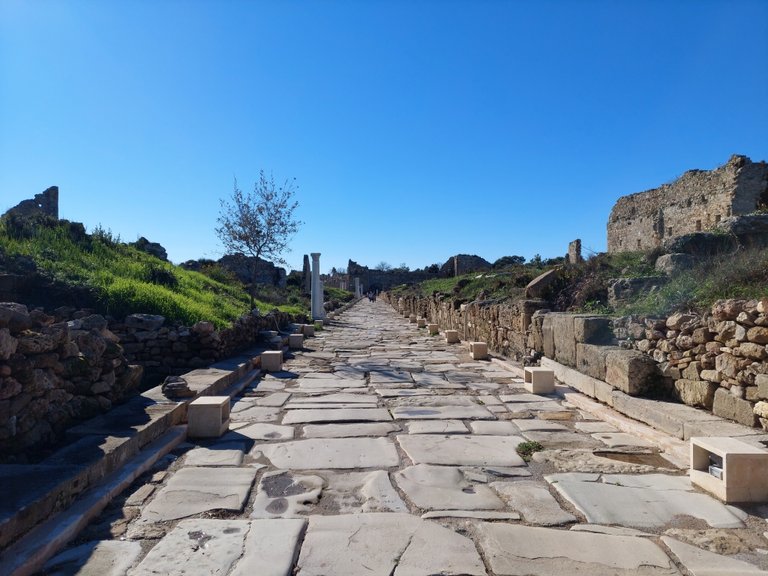
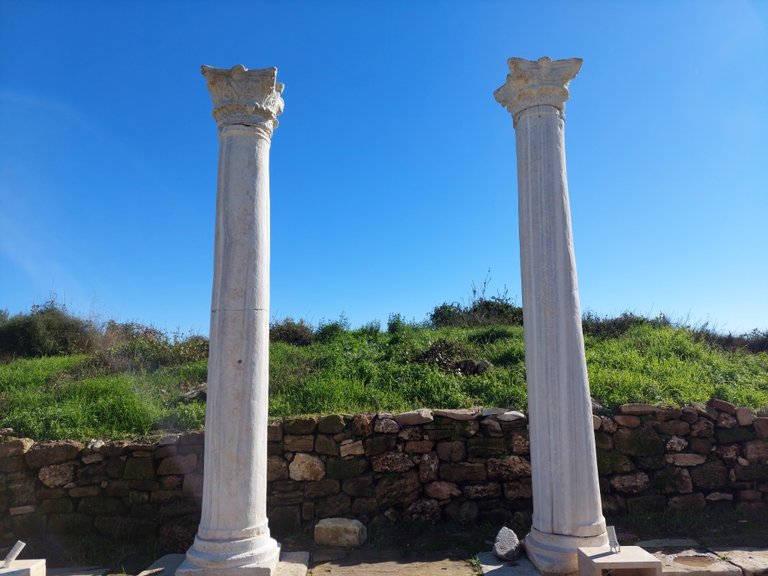
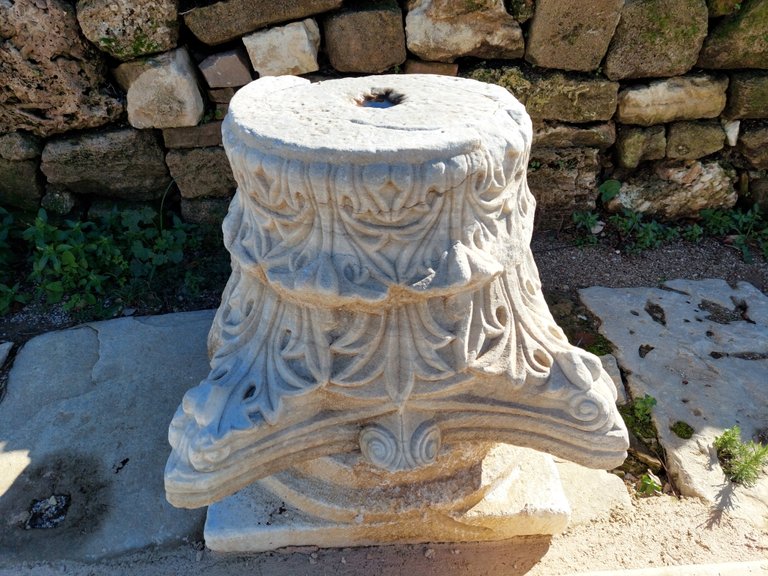
The State Agora - Devlet Agorası
The State Agora boasts a vast square with remnants of buildings on both sides. On one side, there's a state building adorned with oyster shells and acanthus flowers. It used to be two stories high, housing statues of popular gods in Side like Athena, Apollo, Nike, among columns. Sections inside included an imperial hall, a library and an archive room. The expansive courtyard in front of it was likely used as a trading area.
Devlet agorası geniş bir meydana sahip. Meydanın her iki tarafında binaların kalıntılarına rastlanıyor. Bir tarafta istiridye kabuklarıyla, akanthus içekleriyle süslü bir devlet binası var. Burası bir zamanlar iki katlıymış ve kolonların arasında Athena, Apollon, Nike gibi Side'de popüler olan tanrıların heykelleri yer alıyormuş. İçinde imparatorluk salonu, kütüphane ve arşiv odası gibi kısımlar bulunurmuş. Önündeki geniş avlunun ise ticaret yeri olarak kullanıldığı düşünülüyor.

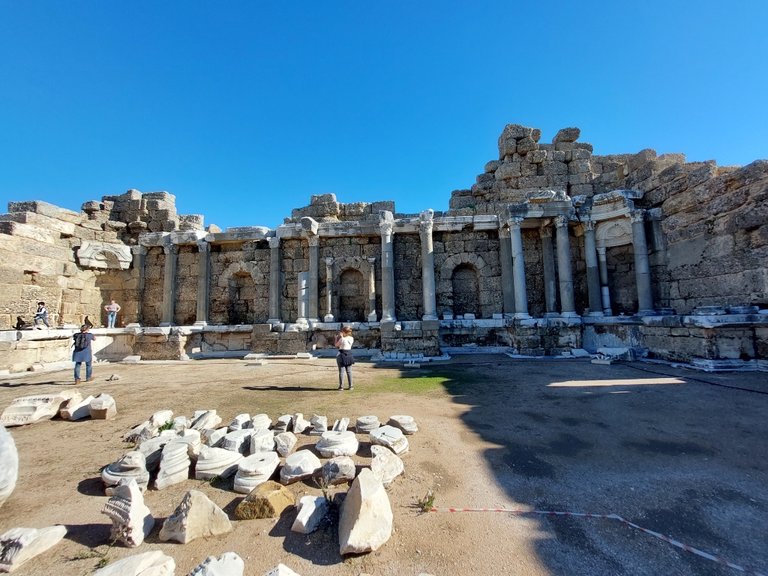
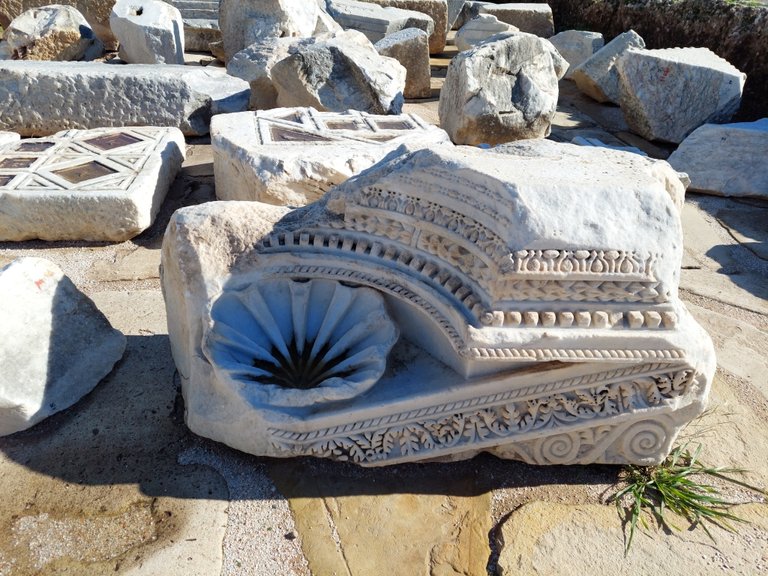
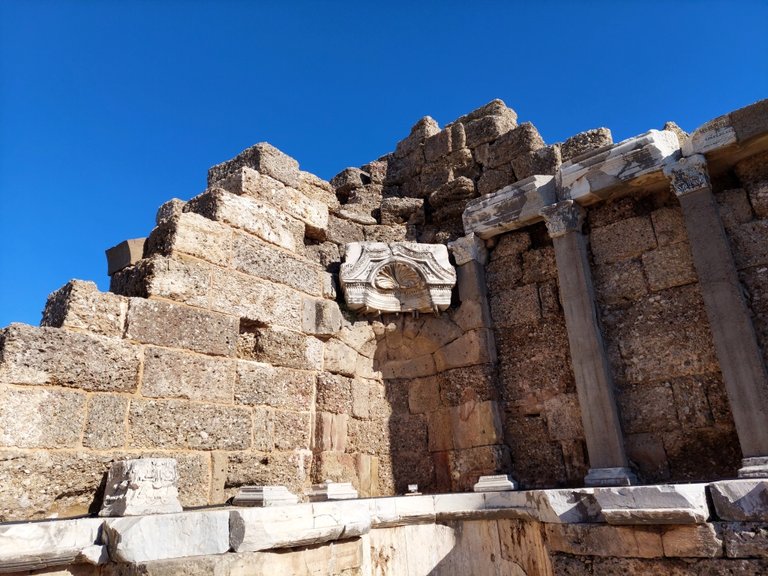
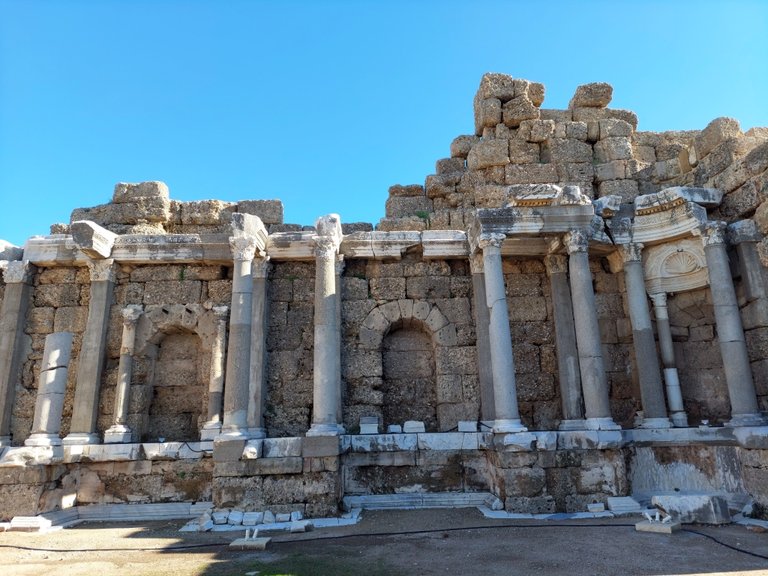
Adjacent to this building in the South Stoa stands another impressive structure. The statues in front are quite impressive, featuring figures of senators, governors and other statesmen as it was a government building. Of course, the artworks currently there are replicas, the originals are exhibited in the Side Museum.
Bu binanın yanındaki güney stoasında ise etkileyici bir başka bina daha bulunuyor. Önündeki heykeller oldukça ilgi çekici. Devlete ait bir bina olduğu için burada senatörler, valiler ve diğer devlet adamlarının heykelleri yer alıyor. Tabii şu anda burada bulunan eserler replika, orijinalleri Side müzesinde sergileniyor.


The Beaches Where Cleopatra Swam - Kleopatra'nın Denize Girdiği Sahiller
It's known that at one point, Side was under the dominion of the Egyptian kingdom. It's highly probable that Cleopatra, as a queen, might have visited this beautiful port of Pamphylia. I'm not certain about historical records of that, but there are rumors about Cleopatra swimming in these shores. Since Side opened to tourism, mentions of Cleopatra have frequently appeared in promotions. Who knows, perhaps she strolled along these shores with Mark Antony.
Side'nin bir dönem Mısır krallığının egemenliği altında olduğu biliniyor. Kleopatra'nın da kraliçe olarak Pamfilya'nın bu güzel limanını ziyaret etme olasılığı çok yüksek. Bununla ilgili tarihi kaynaklar var mı bilmiyorum ama bu sahillerde Kleopatra'nın denize girdiği ile ilgili söylentiler var. Side turizme açıldığı yıllardan beri tanıtımlarda Kleopatra'nın adına sıkça rastlamak mümkün. Kimbilir, belki de Mark Antony'yle bu sahillerde dolaşmışlardır.

In ancient times, this sea wasn't called the Mediterranean but the Pamphylian Sea. Writers of Alexander the Great depict the Pamphylian Sea as if it bowed before the commander. [4] Maybe they just encountered the sea's choppy waters on the day of their visit, much like I did :)
Antik dönemde bu denizin adı Akdeniz değil, Pamfilya deniziydi. Büyük İskender'in yazarları Pamfilya denizinin adeta komutanın önünde eğilerek onları karşıladığını yazarlar. [4] Belki de sadece ziyaret günümde olduğu gibi denizin dalgalı haline denk gelmişlerdir :)
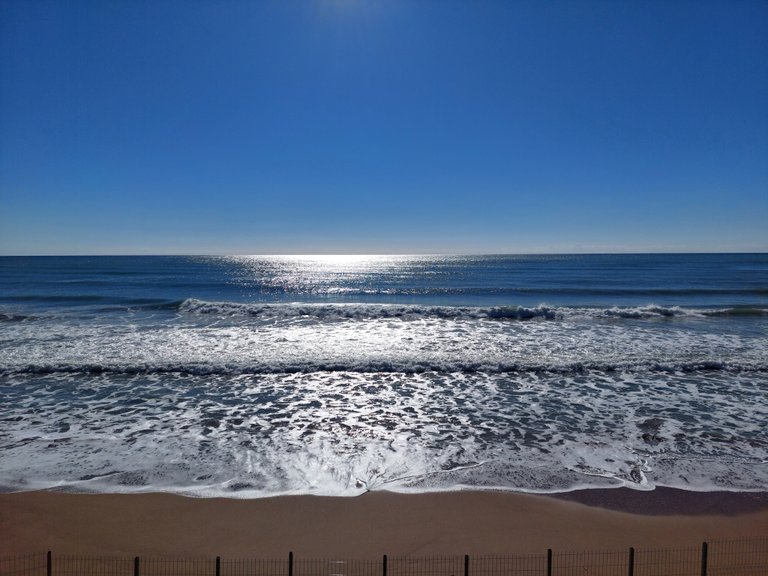
Interestingly, these same writers mention arriving in Side where the mountains reach the sea. They even mention it as 'just like in Lycia.' In today's Side, the mountains are quite far away. I shared about visiting other Pamphylian cities with you before, such as Perge. It stays more inland and closer to the mountains. But in modern and ancient Side, the mountains are quite a distance away.
Ayrıca çok ilginçtir, aynı yazarlar dağların denize kadar ulaştığı Side'ye vardıklarından bahsederler. Hatta bundan "tıpkı Likya'da olduğu gibi" diye bahsederler. Bugünkü Side'de dağlar çok uzakta. Diğer Pamfilya kentlerini ziyaret ettiğimde sizlerle paylaşmıştım. Örneğin, Perge bunlardan biri. Daha iç kısımlarda kalıyor ve dağlara biraz yakın. Ama modern ve antik kalıntıların yer aldığı Side'den dağlar bayağı bir uzak.
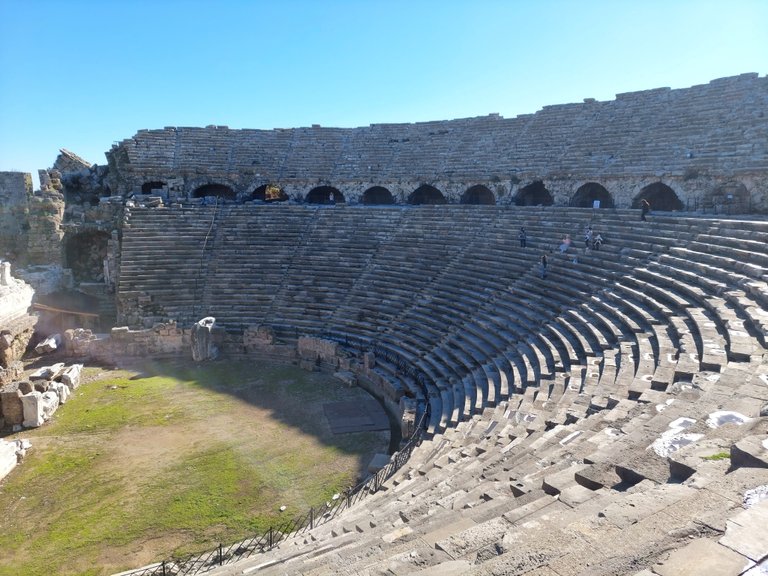
The Ancient Theater - Tiyatro
Speaking of mountains, we usually see ancient theaters leaning against the slopes of hills. Side's theater is quite different. Archways were built first and the theater leans against these arches. In this sense, Side's theater is a unique example in Anatolia. It's an incredibly large theater, accommodating approximately 15000 people. It can't be strictly called a Hellenistic or Roman theater because it embodies features of both. This part might be a bit confusing.
Dağ demişken, genelde antik tiyatroların dağların yamaçlarına yaslandıklarını görürüz. Side tiyatrosu çok farklı. Önce kemerler inşa edilmiş ve tiyatro bu kemerler yaslanmış. Bu anlamda Side tiyatrosu Anadolu'da türünün tek örneği. Çok çok büyük bir tiyatro, yaklaşık 15 bin kişi alıyor. Tam olarak Hellen ya da Roma tiyatrosu denilemiyor, çünkü her ikisinin de özelliklerini taşıyor. Bu kısım biraz kafa karıştırıcı.
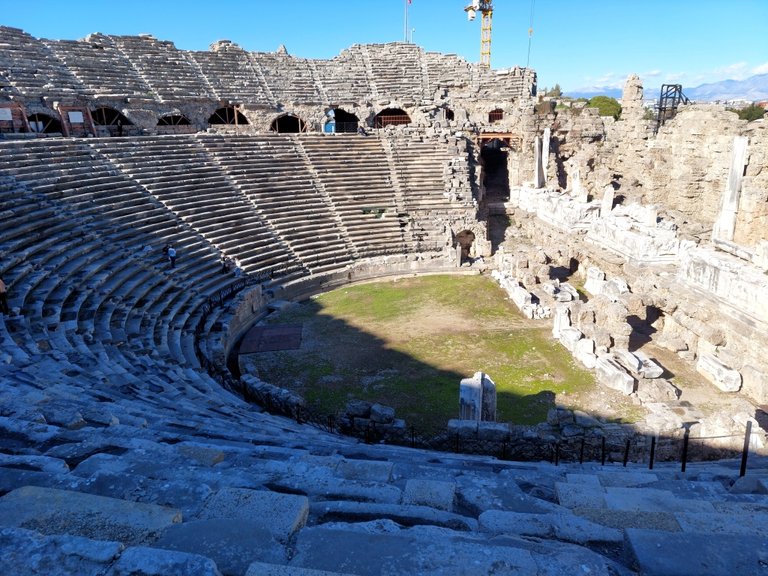

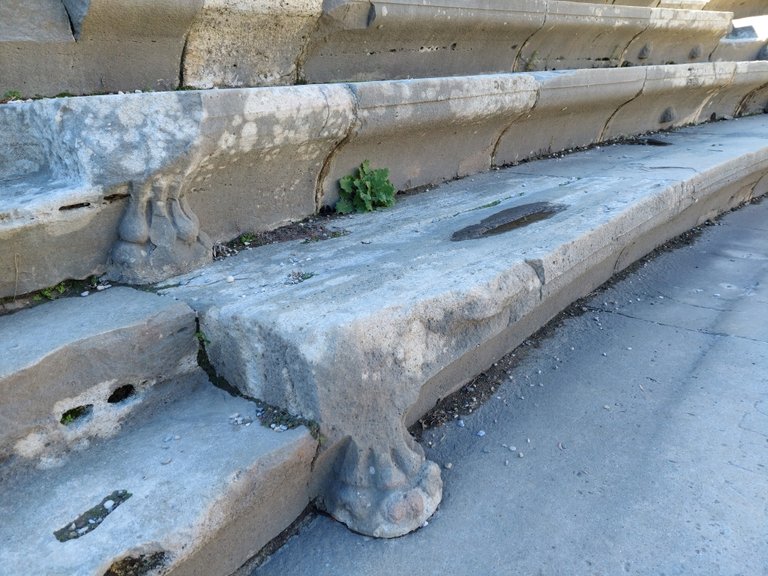
In the stage area, there are sculptures depicting battle scenes and related to Dionysus. We can see sculptures of theater masks here, which were popular in ancient theaters. These masks helped actors convey different emotions, they were usually made of wood or leather and designed to cover the wearer's face.
Sahne bölümünde savaş sahneleri ve Diyonisos ile ilgili heykeller var. Ayrıca antik tiyatrolarda popüler olan tiyatro maskeleri heykellerini burada da görüyoruz. Antik tiyatrolarda bu maskeler oyuncuların farklı duyguları aktarmalarına yardımcı oluyorlardı. Genellikle ahşap veya deriden yapılırdı ve kişinin yüzünü kaplayacak şekilde tasarlanırdı.
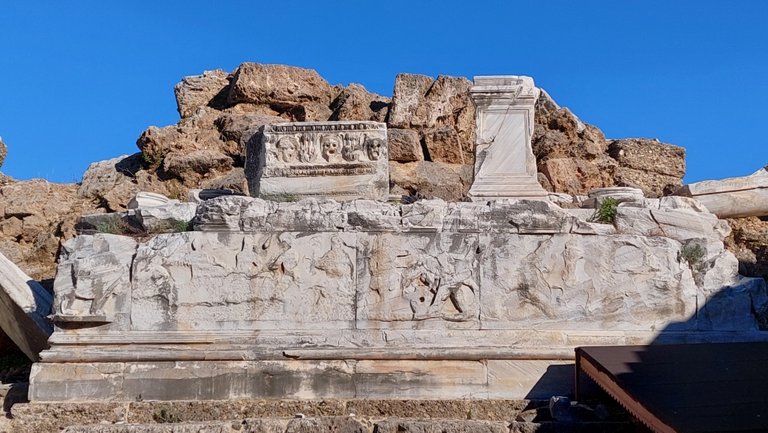
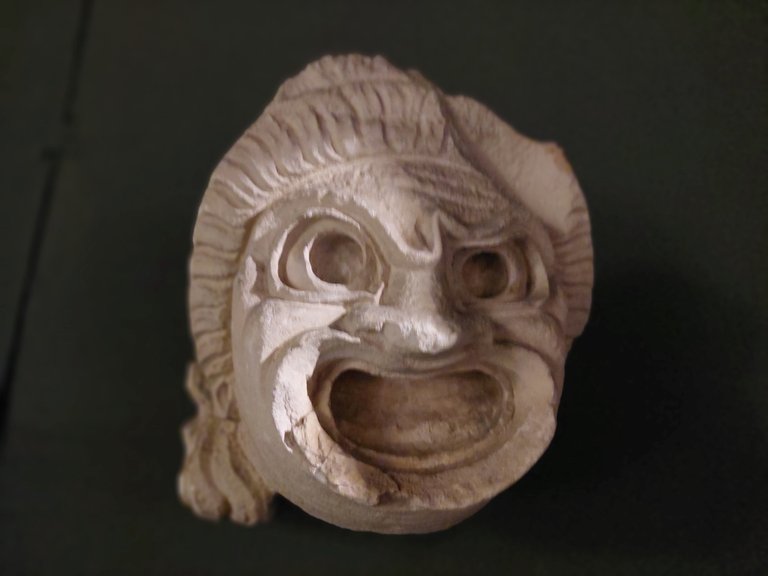
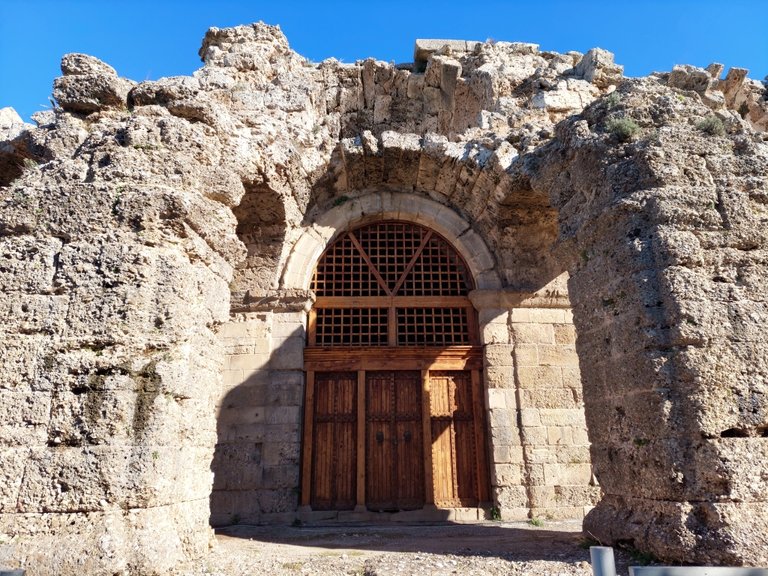
The Fountain of Vespasianus - Vespasianus Çeşmesi
Next to the theater, there's a fountain dedicated to Emperor Vespasian. There's been some debate about its exact location. At the center of the fountain, there used to be a statue of the emperor. Considering its considerable height, it's evident that the emperor was highly esteemed in these parts. However the people of Side seemed to have erected larger monuments in memory of those they held in even greater reverence, be it individuals or gods. For instance, while the statue and temple of Apollo were substantial, those of his twin, Artemis, appeared comparatively smaller. The cult of Artemis, as I've mentioned in earlier discussions, was more prevalent in Perge and the smaller statues here might be seen as a sign of the underlying rivalry between Side and Perge.
Tiyatronun yan tarafında imparator Vespasianus'a adanmış bir çeşme bulunuyor. Yerinin burası olması gerektiği konusu biraz tartışmalı. Çeşmenin ortasında bir zamanlar imparatorun heykeli varmış. Çok yüksek bir yapı olduğuna göre imparatorun buralarda saygın biri olarak kabul gördüğü çok açık. Sideliler daha çok saygı gösterdikleri kişi ya da tanrıların anıları daha büyük yapmışlar. Örneğin Apollon'un heykeli ve tapınağı çok büyükken ikizi Artemis'in heykelleri küçücük kalmış. Artemis kültü daha önceki yazılarımda anlattığım gibi, Perge'de daha yaygındı ve buradaki heykellerinin küçük olması Side ile Perge arasındaki soğuk savaşın bir işareti olarak da görülebilir.
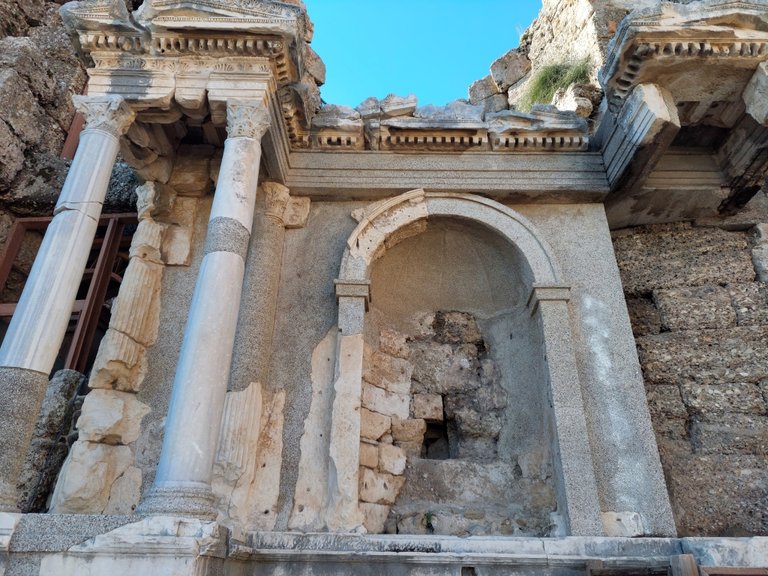
The Temple of Dionysus - Dionysos Tapınağı
Next to the theater stands a temple dedicated to Dionysus. It's known to have been constructed during a later period, specifically during the reign of Emperor Augustus. There's speculation that it might have been repurposed for different uses later on. It's quite common to find that temples were repurposed in later periods for functions such as monasteries, military headquarters or libraries.
Tiyatronun yan tarafında Dionysos'a adanmış bir tapınak var. Daha geç dönemde, imparator Augustus zamanında yapıldığı biliniyor. Daha sonra farklı amaçlarla kullanılmış olabileceği ihtimali üzerinde duruluyor. Tapınakların geç dönemlerde manastır, askeri karargah ya da kütüphane gibi farklı amaçlarla kullanıldığını sıkça görüyoruz.
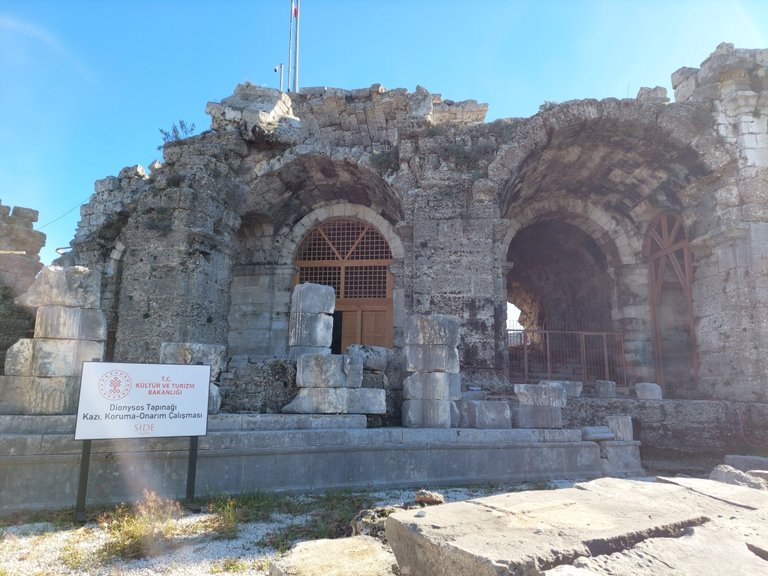
Side Houses - Side Evleri
Remnants of small houses are found along the streets. Once, while wandering among the ruins of these houses, I met a local and had a conversation. Some locals have intricate knowledge about every detail of the ancient city and can share very interesting things. One person told me that this house was used as a brothel in the later periods and the evidence seemed to corroborate their statement. There was a section with a bath and another with bedrooms. These aren't widely recognized structures. Researchers conducting excavations struggle to find sponsors for such places. There was once an article in the press saying that when people learned the house was a brothel, they avoided sponsoring it. They probably don't want their names associated with such a discovery.
Caddeler boyunca küçük evlerin kalıntılarına rastlanıyor. Bir keresinde bu evlerin yıkıntıları arasında dolaşırken buranın yerlilerinden biri ile karşılaşıp muhabbet etmiştim. Bazı yerliler antik kent ile ilgili her bir detayı bilirler ve çok ilginç şeyler anlatabiliyorlar. Bana bu evin geç dönemlerde genelev olarak kullanıldığını anlatmıştı. İşaretler dediğini doğrular nitelikteydi. Evin bir bölümünde hamam diğer bölümünde yatak odası yer alıyordu. Bunlar çok bilinen yapılar değil. Kazı yapan araştırmacılar bu tür yerlere sponsor bulmakta zorlanıyorlar. Bir keresinde basında çıkan yazıda herkes evin genelev olduğunu öğrendiğinde sponsor olmaktan kaçıyor şeklinde yazı çıkmıştı. Muhtemelen adlarının böyle bir keşifle anılmasını istemiyorlar.
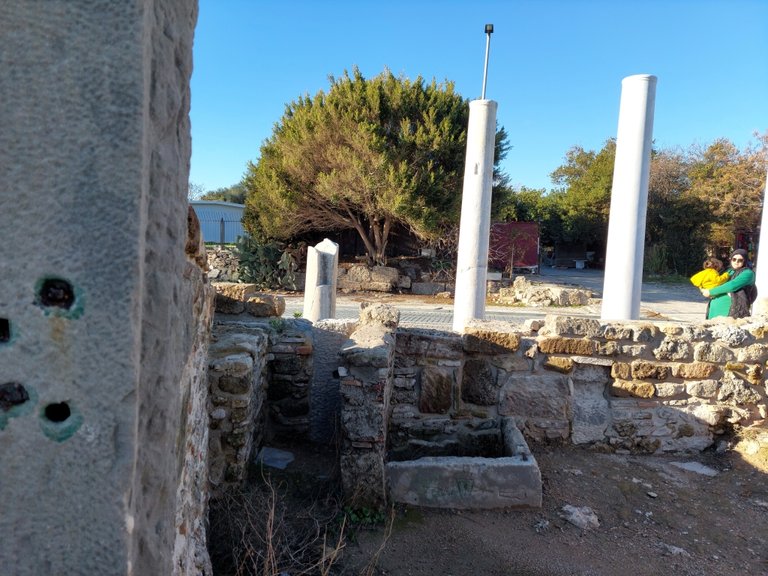

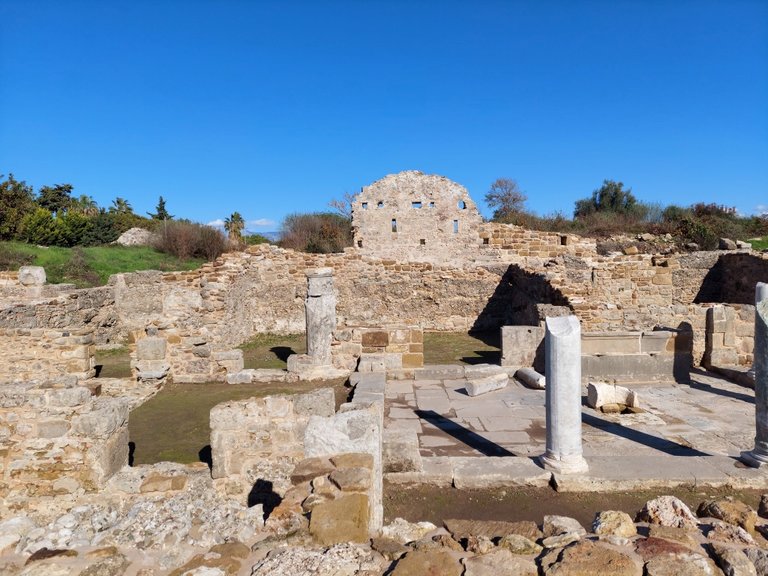
Side Plants - Side Bitkileri
It's enjoyable to wander in deserted places, away from the crowds in ancient cities. In places where human hands haven't touched much, it's possible to come across interesting plants. Some of these are prohibited from being plucked as they are endemic species. The plant of Side is the broomrape, but I don't know exactly when its season is. It can probably be found if one visits in spring. Despite it being winter, I still saw a few beautiful flowers. I mainly encountered laurel, olive and plane trees. While I was there, I didn't forget to gather a few laurel leaves. I really love the scent of laurel, it reminds me of my mother's borscht soup.
Antik kentlerde kalabalıklardan ayrılıp ıssız yerlerde dolaşmak zevkli oluyor. İnsan elinin fazla değmediği yerlerde ilginç bitkilere rastlamak mümkün. Bunların bazıları endemik bitkiler olduğundan koparılmaları yasaklanmış. Side'nin bitkisi canavarotu, ama mevsimini tam bilmiyorum. Muhtemelen ilkbaharda gelinirse rastlanabilir. Kış mevsimi olmasına rağmen yine de güzel birkaç çiçek gördüm. Ağırlıklı olarak defne, zeytin, çınar ağaçlarıyla karşılaştım. Gelmişken birkaç yaprak defne toplamayı da ihmal etmedim. Defne kokusunu çok severim, annemin borş çorbasını hatırlatıyor.
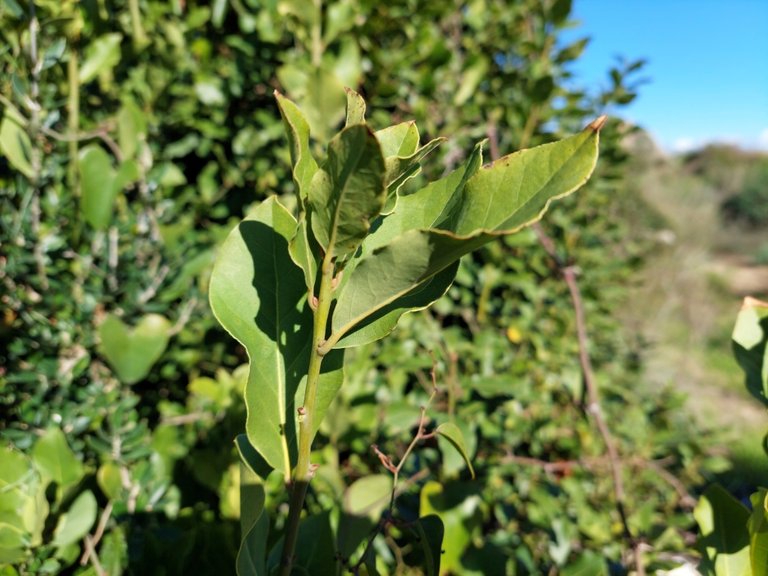

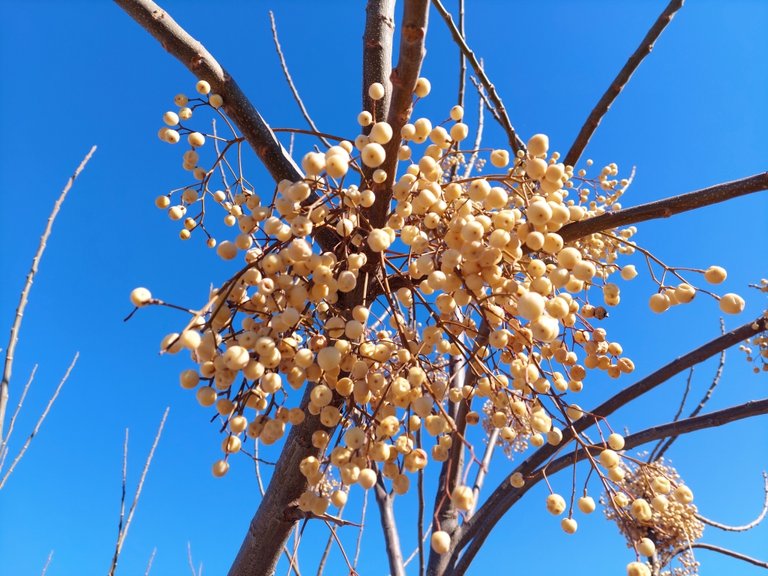
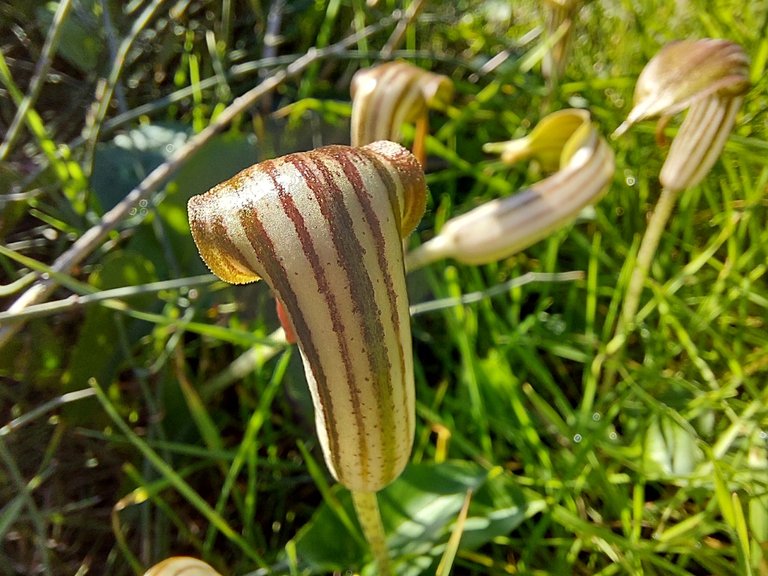

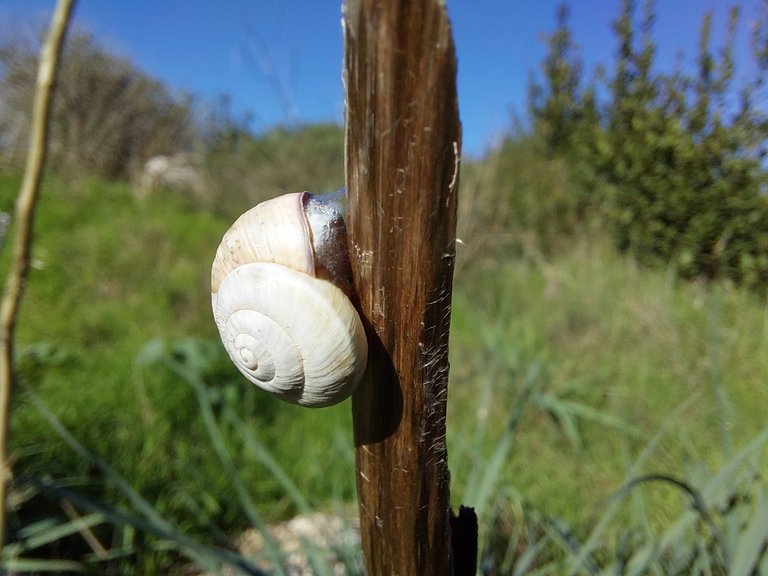
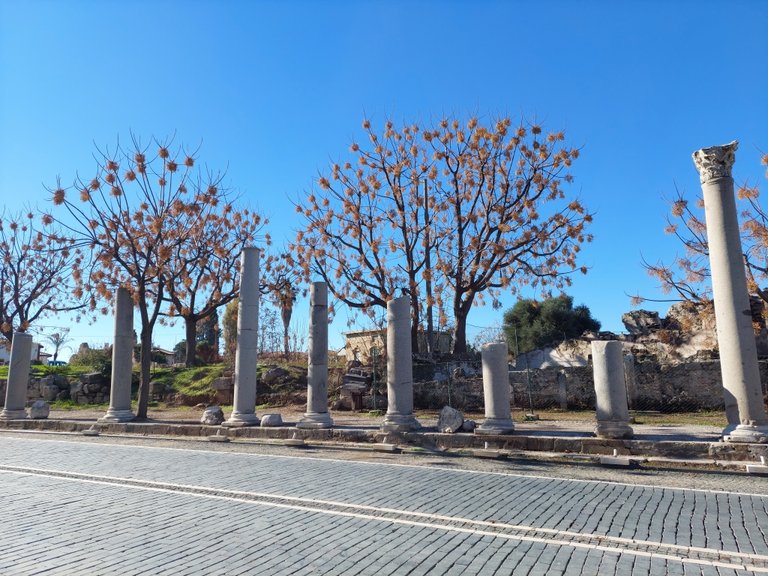
Hoping to see lizards and snakes, I wandered among the rocks for a while. The Side lizards are no different from chameleons, they camouflage very well. That's why this time I couldn't be very successful. I had to settle for just watching their tails.
Kertenkele ve yılan görürüm umuduyla taşların arasında bir süre dolaştım. Side kertenkelelerinin bukalemunlardan hiç farkı yok, çok iyi kamufle oluyorlar. Bu yüzden bu kez çok başarılı olamadım. Sadece kuyruğunu izlemekle yetindim.

Temple of Apollo - Apollon Tapınağı
The Temple of Apollo is one of the most beautiful temples that has become a symbol of Side. It is a favorite spot for those who want to watch the sunset. The temples of Apollo and Athena are located next to each other, reflecting the popularity of these two gods in Side, as evidenced by statues and temples.
Side'nin simgesi haline gelmiş en güzel tapınaklarından biri. Burası güneşin batışını izlemek isteyenlerin favori noktalarından biri. Apollon ile Athena tapınakları birbirlerinin yanında yer alıyor. İkisi de Side'nin en popüler tanrıları olmuşlar. Bunu heykellerden ve tapınaklardan anlamak mümkün.

Athena's symbols are generally a shield and a laurel. [5] In Side, she was seen as the protector of sailors, and her statues were adorned with the local symbol, the pomegranate.
Athena'nin simgeleri genelde kalkan ve defnedir. [5] Ate Side'de denizcilerin koruyucusu olarak görülmüş ve heykelleri yerel sembol olan narla süslenmiştir.

Apollo emerges as another important deity in Side, known as the god of art and the sun. Today, the temple observes the sun abundantly, suggesting a possible connection with the sun. The people of Side considered him the founder of the city and gave him the title "Sidetes." The abundance of Apollo head sculptures is not a coincidence, it was believed that Apollo purified the area from evils, and it was said that poisonous reptiles could not live in his sacred space. [5]
Apollon ise Side'nin diğer önemli tanrısı olarak karşımıza çıkıyor ve sanatın, güneşin tanrısı olarak biliniyor. Bugün tapınağı güneşi bol bol izliyor, buraya yapılmasının güneşle alakası olma ihtimali olabilir. Sideliler onu kentin kurucusu olarak kabul edip Sidetes lakabını vermişler. Ayrıca çok fazla Apollon kafası heykeli ile karşılaşmamız tesadüfi değil. Apollon'un kötülüklerinden arındırdığına inanılırdı ve özellikle zehirli sürüngenlerin onun kutsal alanında yaşayamadığı söylenirdi. [Kaynak 5]
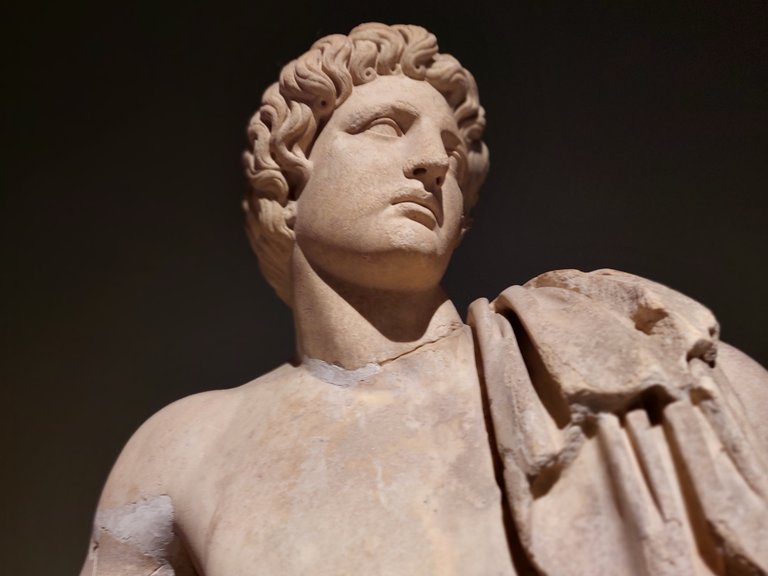


The City Gate - Kent Kapısı
Large sections of walls remain behind the main gate of the city. Towers were built on both sides of the gates, surrounded by walls. It seems that the purpose of this was to defend against invasions from the north. However historical records do not indicate that Side engaged in many wars. When Alexander the Great arrived, the people of Side opened their gates to him without resistance. The writers of the famous commander noted that while Alexander faced difficulties in conquering Termessos, he easily captured Side without a fight. [4]
Kentin ana kapısından geriye büyük ölçüde surlar kalmış. Her iki tarafı surlarla çevrili kapıların iki tarafına kuleler yapılmış. Görünüşe göre buranın amacı kuzeyden gelen istilalardı. Gerçi tarihte Side'nin çok fazla savaşa girdiği bilgisi yer almıyor. Büyük İskender geldiğinde Sideliler hiç direnmeden kapılarını kendisine açmışlar. Ünlü komutanın yazarları İskender'in Termessos'a bulaşmakla başına dert aldığını, Side'yi ise savaşmadan kolaylıkla ele geçirdiğini yazmışlar. [4]
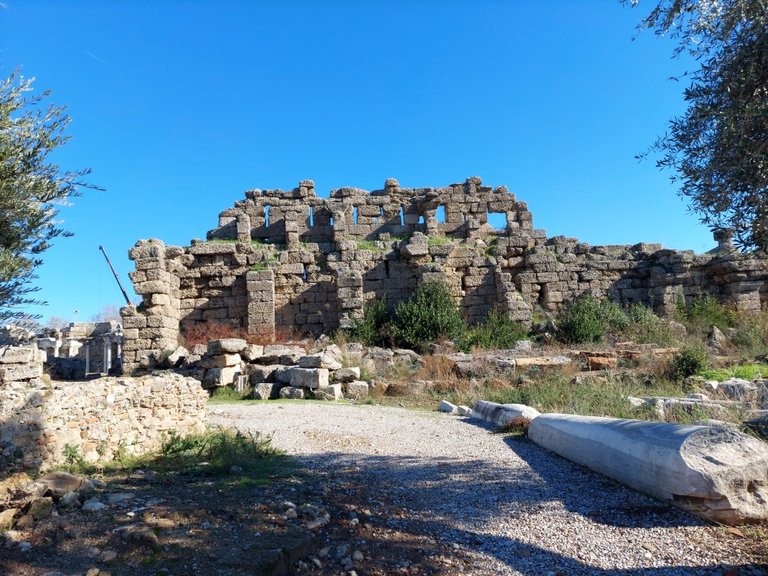
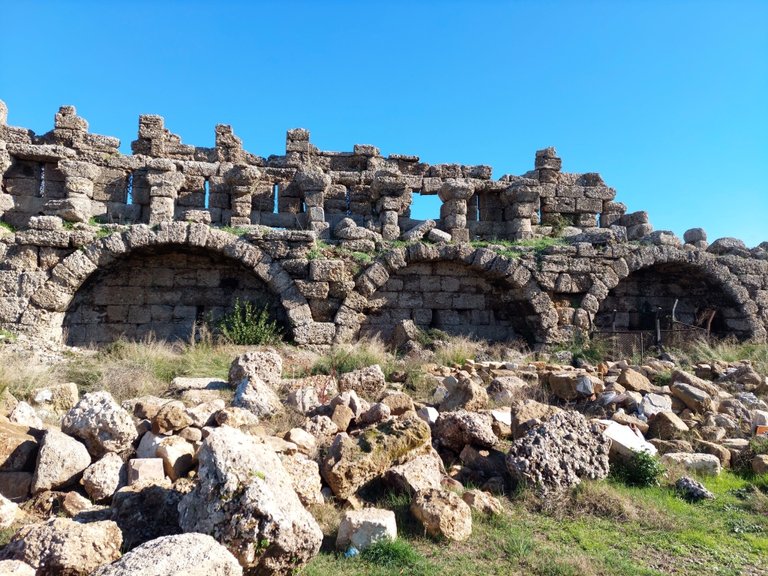
The Byzantine Hospital - Bizans Hastanesi
There is a small hospital building, and its architecture indicates that it belongs to a more recent period. The symbols inside suggest that this place was used as a hospital at some point. The entrances from the Roman era have been closed off by the Byzantines or later occupants, who made modifications according to their needs. It is possible to find traces of drainage on the walls.
Küçük bir hastane binası var. Yapı itibariyle daha yakın geçmişe ait olduğu belli oluyor. İçindeki sembollerden buranın bir dönem hastane olarak kullanıldığı anlaşılmış. Romalılardan kalma girişleri Bizanslılar ya da sonradan gelen diğerleri kapatmışlar ve kendilerine göre değişiklikler yapmışlar. Duvarlarda kanalizasyon izlerine rastlamak mümkün.
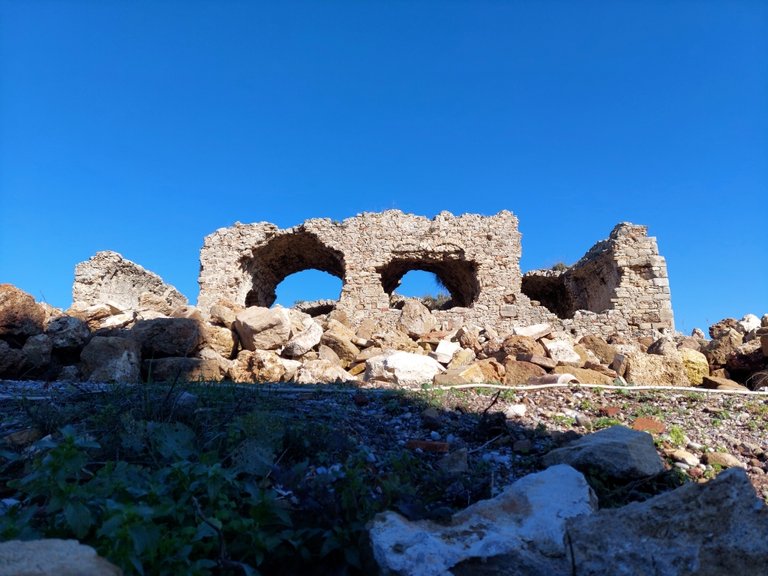

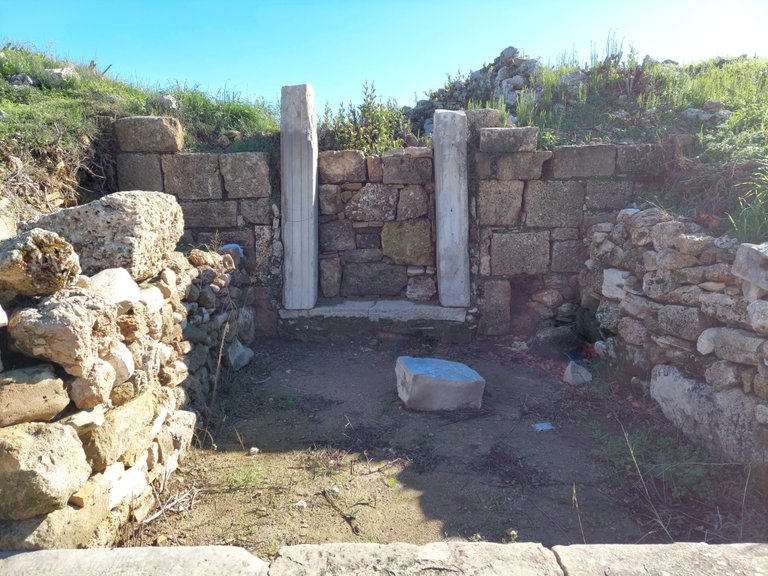
Necropolis - Nekropol
At the entrance of Side, there is a small necropolis featuring a few sarcophagi and a monument. Due to contributions from various civilizations throughout history, it is currently unknown to whom the monument exactly belongs. In my opinion, this magnificent city likely had a larger necropolis. Excavations are ongoing and more discoveries are expected to come to light over time. The found burial types are generally in the form of sarcophagi. Apparently, due to the absence of rocks, tombs here are mostly constructed using stone and marble.
Side'nin girişinde küçük bir nekropol yer alıyor. Birkaç lahit ve bir anıt var. Tarih boyunca her gelen uygarlıktan buraya bir şeyler eklendiği için anıtın tam olarak kime ait olduğu henüz bilinmiyor. Bence bu görkemli kentin daha büyük bir nekropolü vardı. Kazılar devam ediyor, zamanla çok daha fazlası gün yüzüne çıkacaktır. Bulunan mezar tipleri genelde lahit şeklinde. Görünüşe göre, kayalar olmadığı için burada mezar olarak çoğunlukla taş ve mermerden yapılan lahitler kullanılmış.
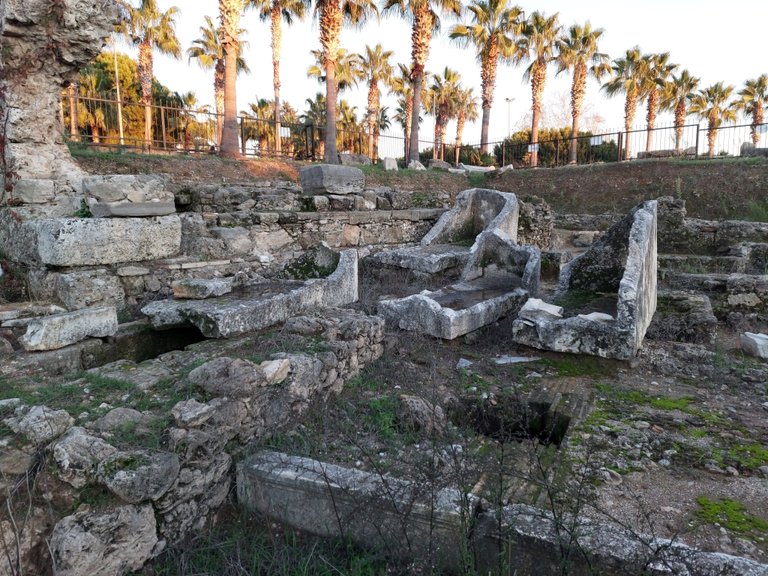
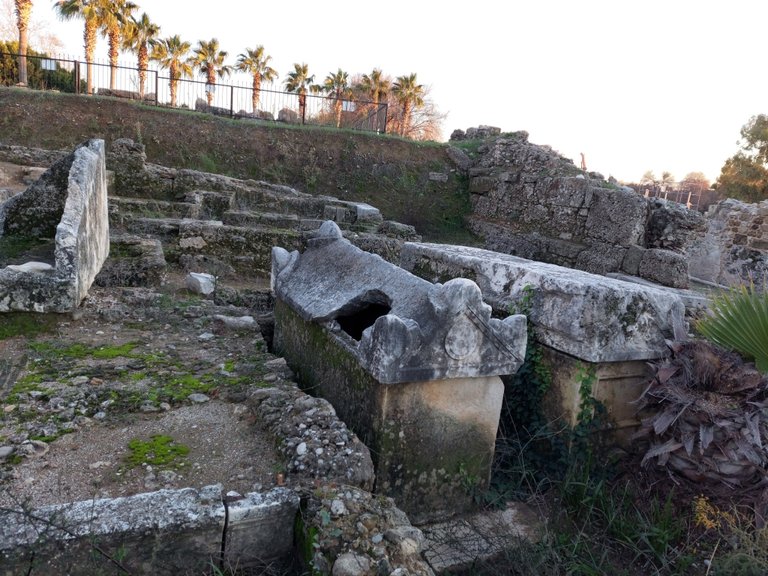
Coffee Break - Kahve Molası
I got a bit tired, so Honey and I went to Cretans Coffee on the beach for a coffee break. It's enjoyable to watch the small boats in the harbor while having Turkish coffee. The café square had a view of the promenade and there were a few brides and grooms strolling around. Apparently, Side has become a popular destination for couples getting married.
Bal da ben de biraz yorulduk ve kahve molası için sahildeki Giritliler kahvesine gittik. Türk kahvesi içerken bir taraftan limandaki küçük tekneleri izlemek keyifli oluyor. Ayrıca kafe meydan manzaralı, burada dolaşan birkaç gelin ve damat vardı. Anlaşılan Side evlenen çiftlerin de popüler destinasyonu haline gelmiş.
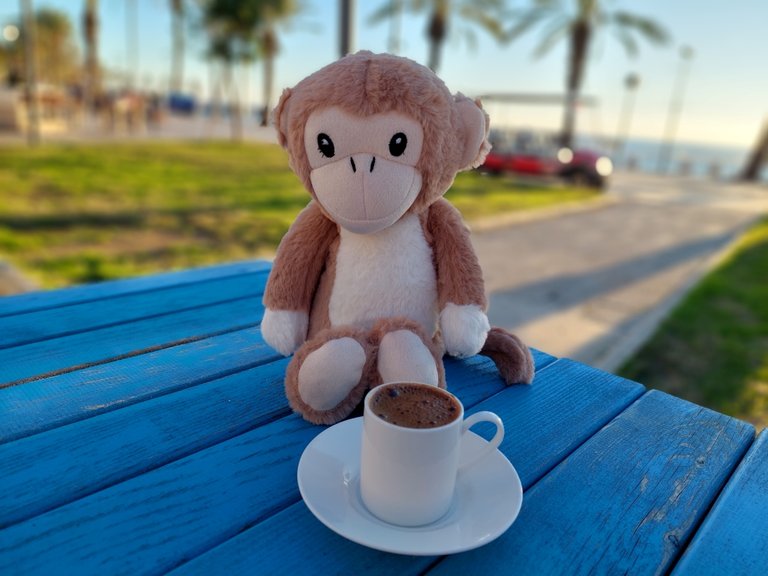

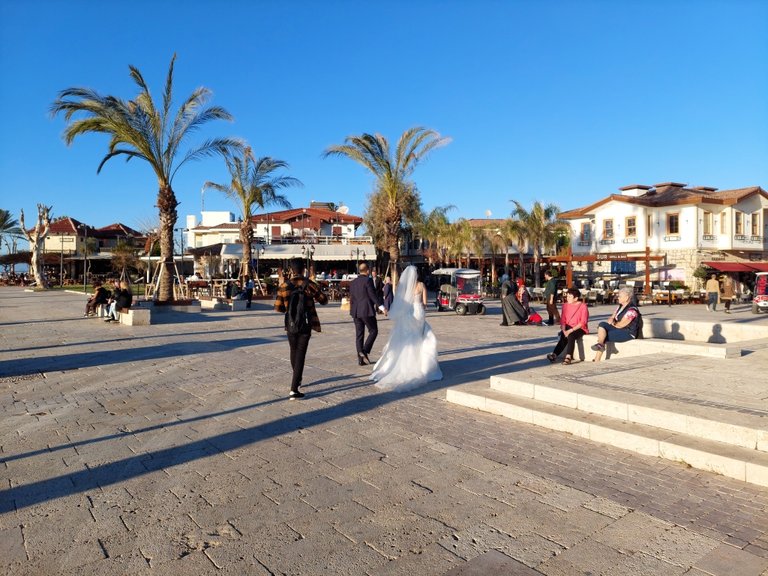

We are in Modern Side - Burası Da Modern Side
Modern Side is as impressive as its ancient counterpart, if not more. The tiny houses made of wood and rubble stone have been transformed into restaurants and shops. One of my favorite features here is the absence of cars. Leaving the cars at the entrance, we reach this place with small and charming Side vehicles.
Modern Side de en az antiği kadar büyüleyici. Ahşap ve yığma taştan yapılmış minik evleri restoran ve dükkanlara dönüştürülmüş. Buranın en beğendiğim özelliği hiç araba olmaması. Arabaları girişte bırakıp buraya küçük ve sevimli Side arabalarıyla ulaşıyoruz.
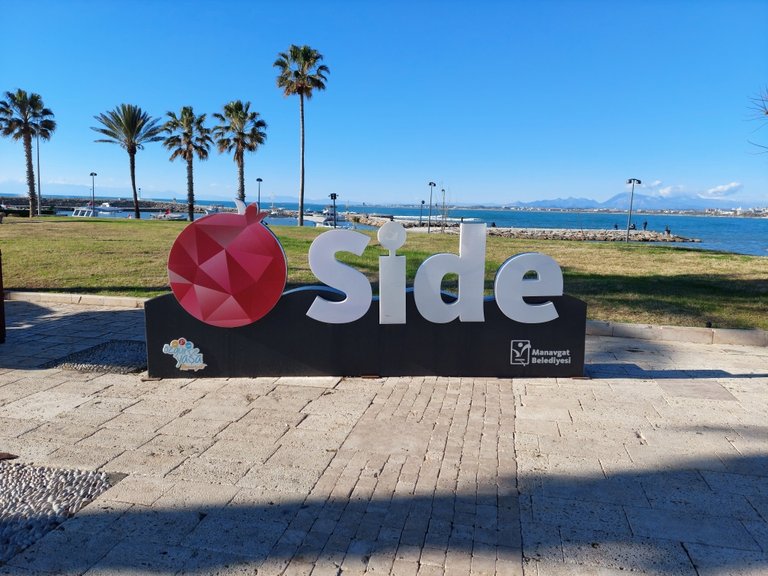
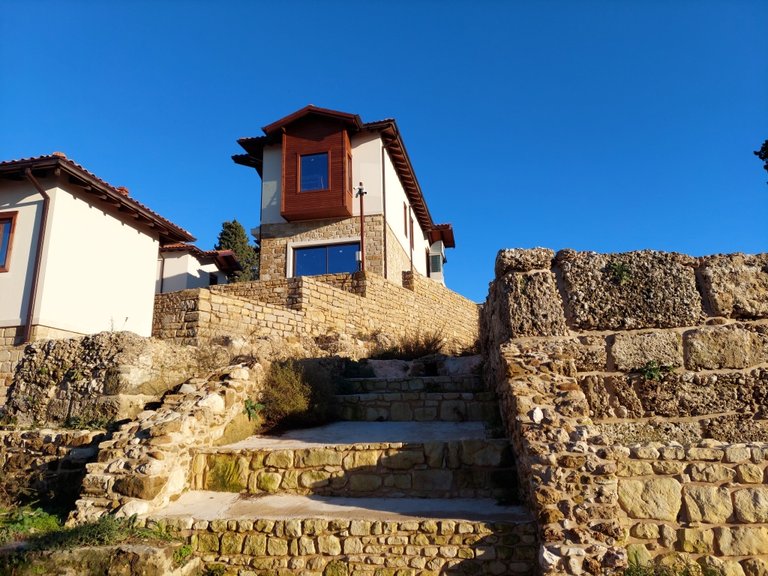
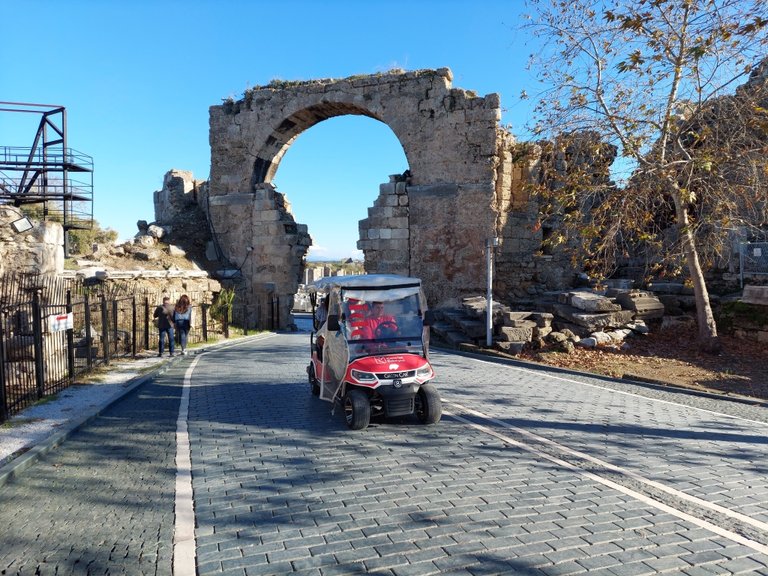
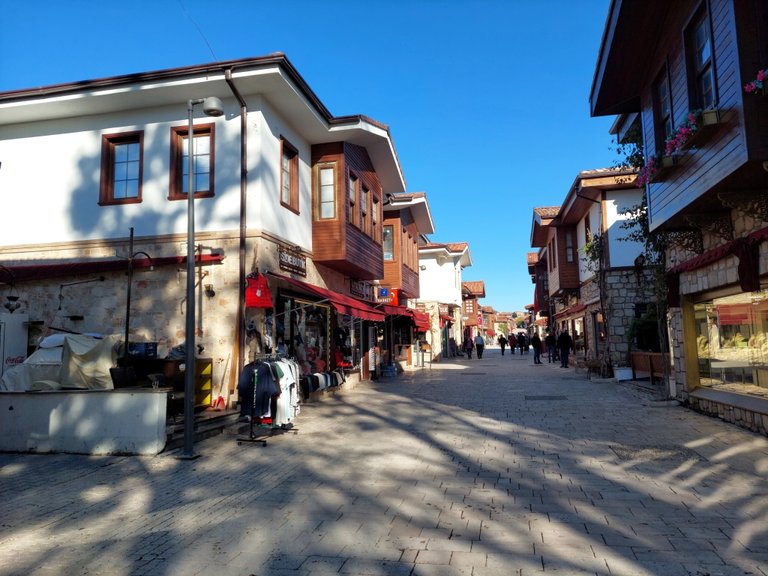

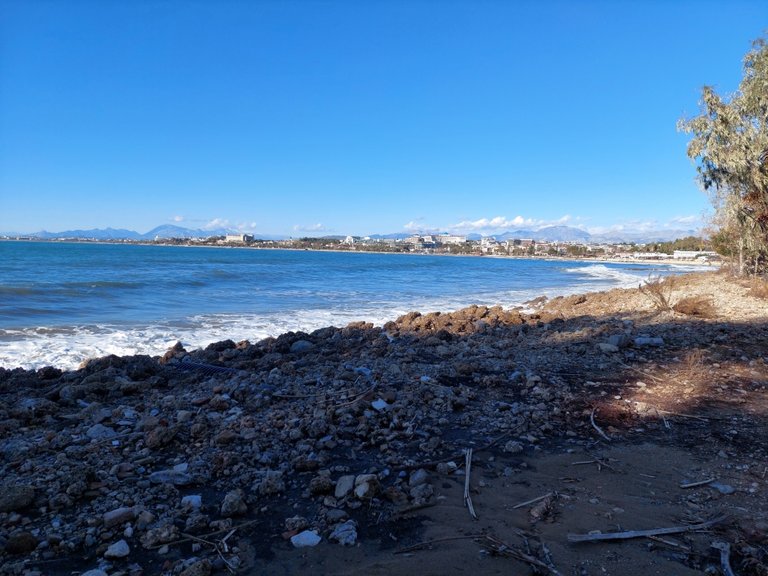

There is also a small harbor below. If you visit in the summer months, you can explore the two museums here. Unfortunately, during my visit, the Side Museum was closed for restoration, so I couldn't explore it. However, a small library has been opened where I took a short tour. Olive and grape pressing tools are exhibited here. It is known that in ancient times, just like today, there were plenty of olive trees in Side.
Aşağıda küçük bir limanı da var. Burada bulunan iki müze yaz aylarında gelinirse gezilebilir. Ziyaretim sırasında Side müzesi restorasyon nedeniyle kapalı olduğundan gezemedim. Küçük bir kütüphane açılmış. İçinde kısa bir tur attım. Burada zeytin ve üzüm presleme aletleri sergileniyor. Side'de antik dönemde şimdi olduğu gibi bolca zeytin ağacı olduğu biliniyor.
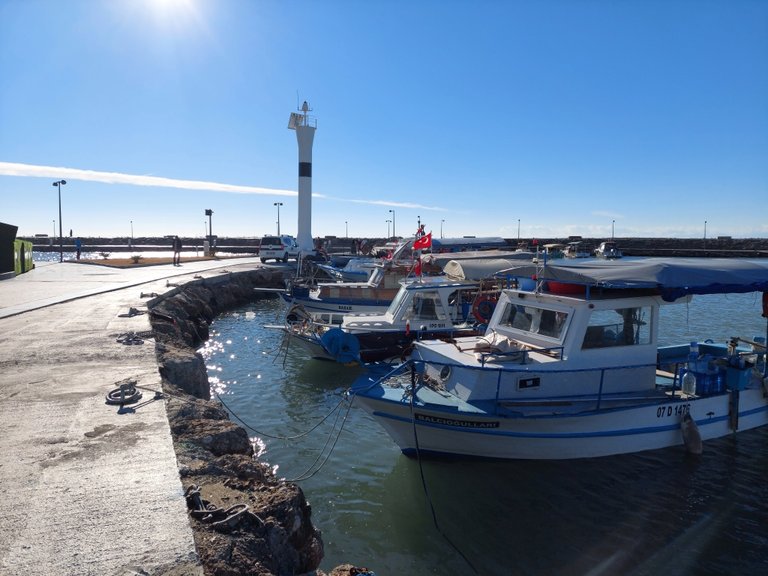
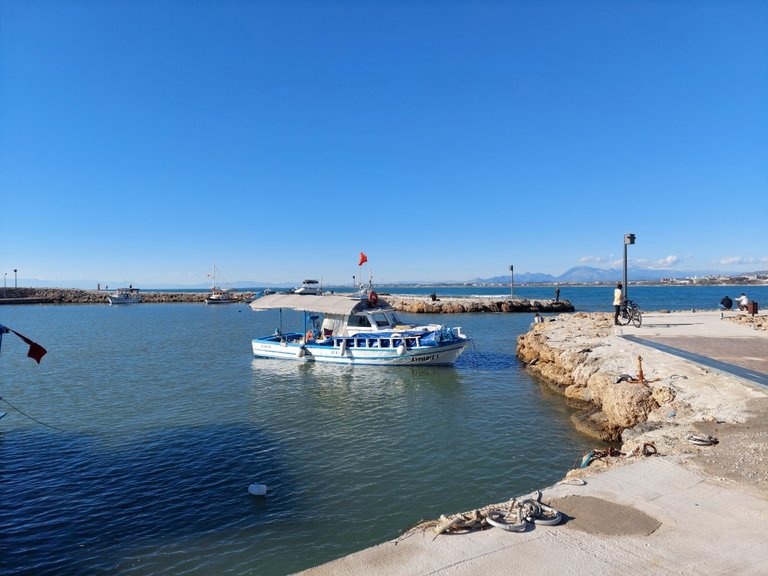


While walking, I came across the inscription of Selimiye village in some places. This was Side's old name. At one point, the name of Sultan Selim was given to this place, and it started to be known as Selimiye.
Yürürken bazı yerlerde Selimiye köyü yazısı ile karşılaştım. Side'nin eski adı bu. Bir dönem sultan Selim'in adı buraya konmuş ve Selimiye olarak bilinmeye başlamış.
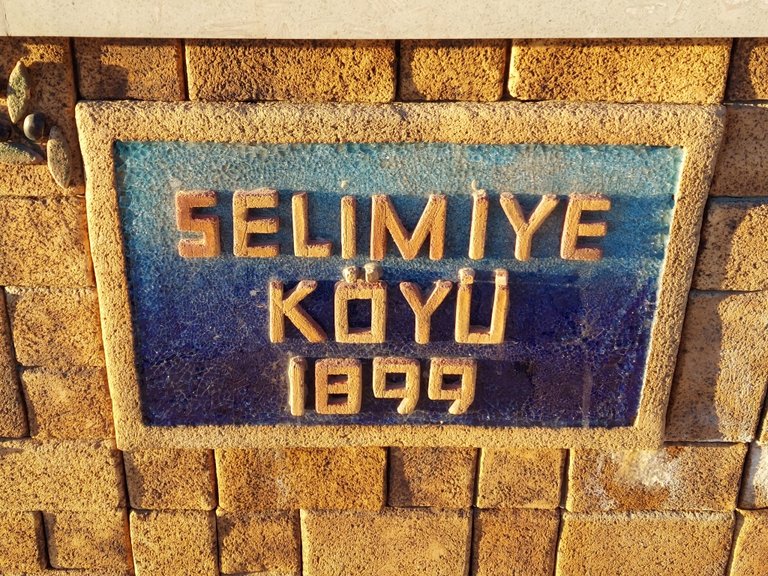
Wandering through the souvenir stores was also a delightful experience. Besides charming souvenirs, it was possible to see the traces of the symbol of Side, the pomegranate, everywhere.
Hediyelik eşyacıları gezmek ayrı bir keyifliydi. Şirin hediyeliklerin yanı sıra Side'nin sembolü olan narın izini her yerde görmek mümkündü.
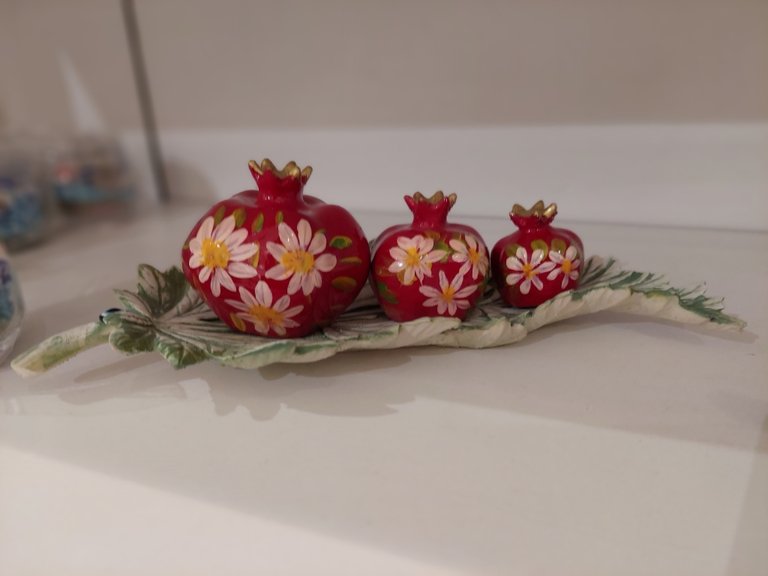
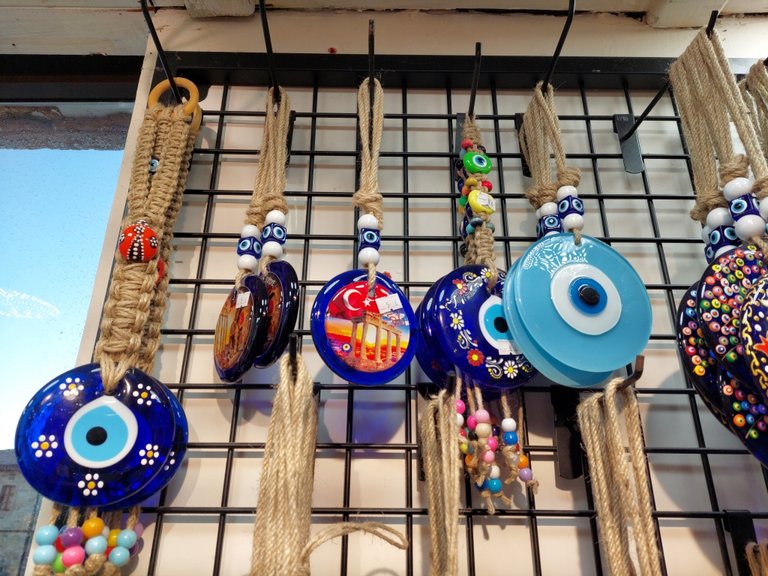
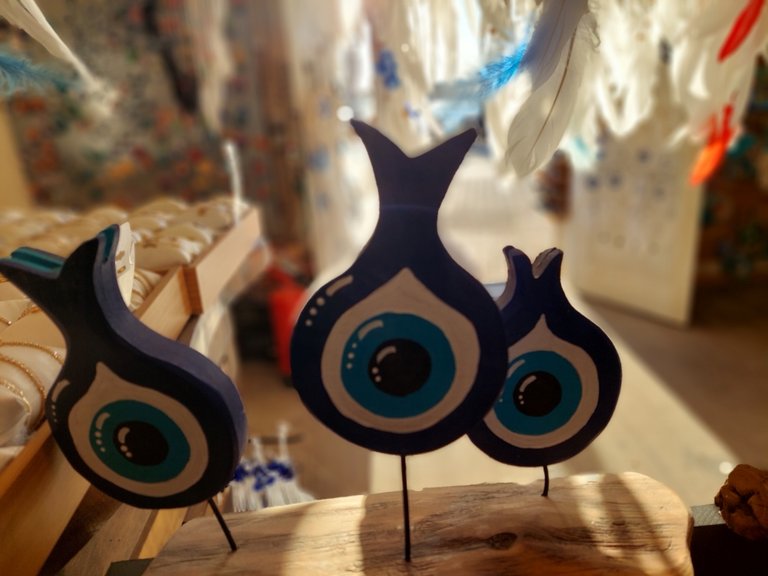

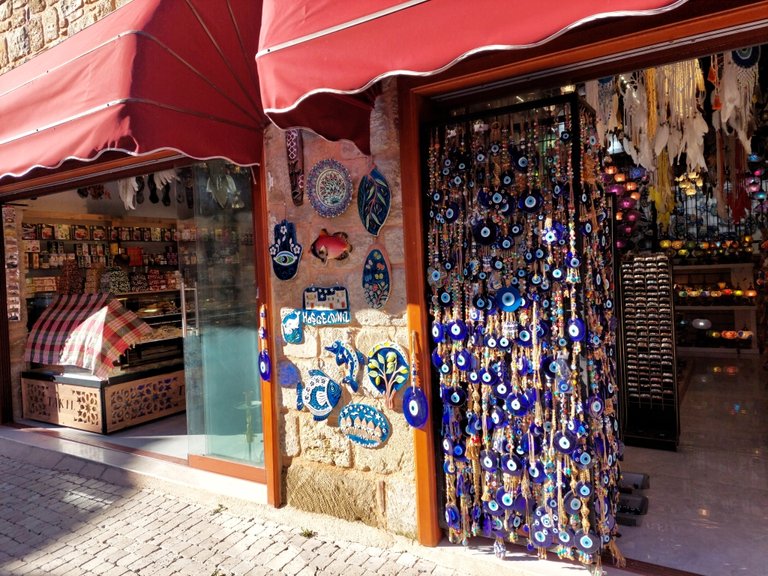
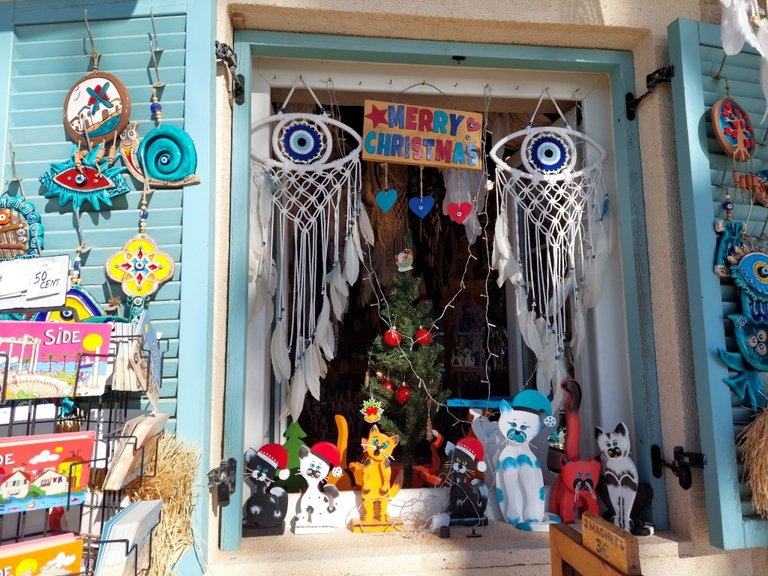
It was a beautiful day. If you happen to be in the area, I highly recommend visiting this city adorned with the colors of pomegranates.
Güzel bir gündü. Yolunuz düşerse narın renkleriyle süslenmiş bu kente uğramanızı mutlaka öneririm.
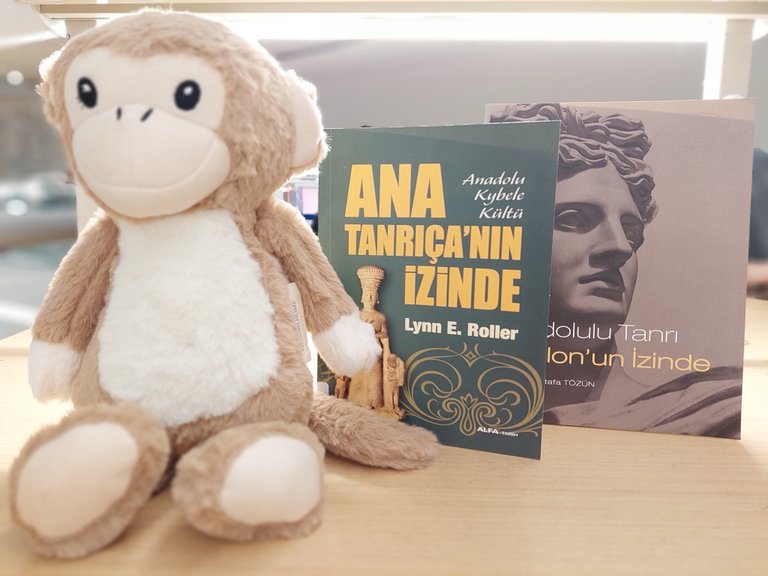
Sources: - Kaynaklar:
- In Search of God the Mother, Lynn E. Roller, p. 135. Year: 2013
- Mythological Stories, Ramazan Demir, 2012
- Strabo. Geographika, 14,3,1. 2012
- Alexander the Great, Kona Lendering, 2018
- In the Footsteps of the Anatolian God Apollo, Mustafa Tözün, p. 39. Year: 2022
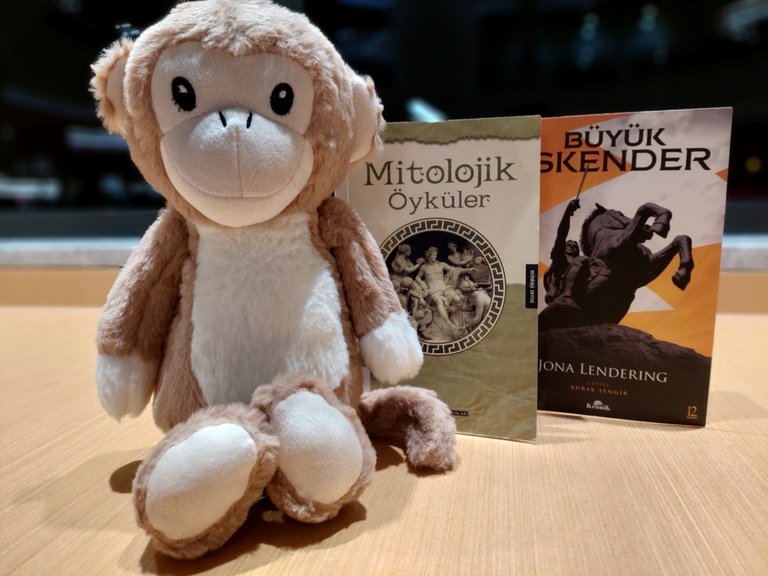
1. Ana Tanrıçanın İzinde, Lynn E. Roller, s. 135. Yılı: 2013
2. Mitolojik öyküler, Ramazan Demir, 2012
3. Strabon. Geographika, 14,3,1. 2012
4. Büyük İskender, Kona Lendering, 2018
5. Anadolulu Tanrı Apollon'un izinde, Mustafa Tözün, s. 39. 2022
